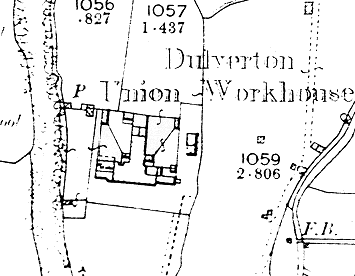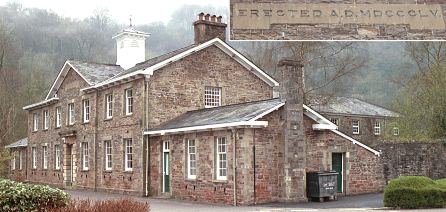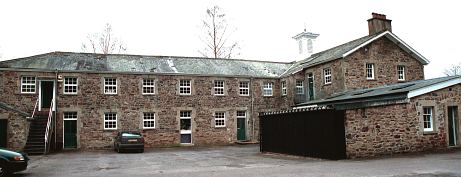Dulverton, Somerset
Up to 1834
No information.
After 1834
Dulverton Poor Law Union was officially formed on 18th May 1836. Its operation was overseen by an elected Board of Guardians, 12 in number, representing its 11 constituent parishes as listed below (figures in brackets indicate numbers of Guardians if more than one):
Somerset: Brompton Regis, Brushford, Dulverton (2), Exford, Exton, Hawkridge, Huish Champflower, Skilgate, Upton, Winsford, Withypoole. Later Addition: Withiel Florey (1896).
The population falling within the Union at the 1831 census had been 4,951 with parishes ranging in size from Hawkridge (population 67) to Dulverton itself (1,285). The average annual poor-rate expenditure for the period 1833-35 had been £2,668 or 10s.4d. per head.
A new Dulverton Union workhouse, designed by Edward Ashworth, was erected on the banks of the River Barle at the west of Dulverton in 1854-5. It was based on a T-shaped layout, with the west half of the workhouse being used for men's and boys' accommodation, with that for women and girls to the east. At the front of the building to the south, the Guardians' board-room lay to the east of the central door, with females' receiving ward and bathroom beyond. To the west of the front door were the inmates dining hall, beyond which the lay males' receiving ward, bathroom and refractory cell. The north wing contained day rooms and dormitories. The site layout can be seen on the 1902 map below.

Dulverton workhouse site, 1902.
© Peter Higginbotham.

Dulverton from the south-east, 2001.
© Peter Higginbotham.

Dulverton from the north-west, 2001.
© Peter Higginbotham.
Following an inspection in 1908, a report noted:
The above-mentioned master, Richard Hammond, died in September 1908, at which time he had held the post for 42 years and was the oldest workhouse master in England. After the death of his wife, Grace, in 1891, the couple's daughter, Sophia, previously schoolmistress at the institution, had succeeded her mother as matron.
After 1930, only the vagrants' casual wards remained in use. The building was subsequently used as the Exmoor Training Centre for Girls. It later became Rural District Council offices under the name of Exmoor House.
The former workhouse building is now (2001) used as administrative offices for the Exmoor National Park.
Staff
Inmates
Records
Note: many repositories impose a closure period of up to 100 years for records identifying individuals. Before travelling a long distance, always check that the records you want to consult will be available.
- Somerset Heritage Centre, Brunel Way, Langford Mead, Norton Fitzwarren, Taunton TA2 6SF. Holdings include: Guardians' minute books (1836-1930); Admissions and discharges (1855-1930, with gaps); Births 1866-1927; Deaths (1866-1930); etc.
Bibliography
- None.
Links
- None.
Unless otherwise indicated, this page () is copyright Peter Higginbotham. Contents may not be reproduced without permission.


